Impact of Land Use Patterns on Flood Risk in the Chang-Zhu-Tan Urban Agglomeration, China
Abstract
1. Introduction
2. Study Area and Data
2.1. Study Area
2.2. Data
3. Methods
3.1. Flood Risk Assessment
3.1.1. Flood Risk Assessment Framework
3.1.2. Construction of a Risk Indicator System for Flood Risk
3.1.3. Multicollinearity Test
3.1.4. Determination of Indicator Weights
3.2. Land Use Simulation
3.3. Probabilistic Flood Risk Prediction
3.3.1. Multilayer Perceptron
3.3.2. Bayesian Network
3.3.3. Model Dataset and Model Construction
3.3.4. Flood Risk Index
4. Results
4.1. Flood Risk Assessment
4.1.1. Hazard Assessment
4.1.2. Exposure Assessment
4.1.3. Vulnerability Assessment
4.1.4. Resilience Assessment
4.1.5. Flood Risk Assessment
4.2. Land Use Simulation
4.3. Probabilistic Flood Risk Prediction
4.3.1. MLP-Based Probabilistic Prediction of Flood Risk
4.3.2. BN-Based Probabilistic Prediction of Flood Risk
4.3.3. Flood Risk Index
5. Discussion
5.1. Flood Risk Assessment
5.2. Probabilistic Flood Risk Prediction
5.3. Policy Recommendations
5.4. Innovations and Limitations
6. Conclusions
Author Contributions
Funding
Data Availability Statement
Acknowledgments
Conflicts of Interest
References
- Tellman, B.; Sullivan, J.A.; Kuhn, C.; Kettner, A.J.; Doyle, C.S.; Brakenridge, G.R.; Erickson, T.A.; Slayback, D.A. Satellite imaging reveals increased proportion of population exposed to floods. Nature 2021, 596, 80–86. [Google Scholar] [CrossRef]
- Bhere, S.; Reddy, M.J. Flood risk assessment of suburban region in India by incorporating flood hazard, vulnerability and exposure. Nat. Hazards 2025, 121, 6625–6649. [Google Scholar] [CrossRef]
- Park, K.; Lee, E.H. Urban flood vulnerability analysis and prediction based on the land use using Deep Neural Network. Int. J. Disaster Risk Reduct. 2024, 101, 104231. [Google Scholar] [CrossRef]
- Dong, B.L.; Xia, J.Q.; Wang, X.J. Comprehensive flood risk assessment in highly developed urban areas. J. Hydrol. 2025, 648, 132391. [Google Scholar] [CrossRef]
- Feng, J.; Tian, Y.; Xie, Z.L.; Wang, H. Risk Assessment of Campus Waterlogging and Evacuation Route Planning. Water Resour. Manag. 2025, 39, 3071–3107. [Google Scholar] [CrossRef]
- Fu, G.T.; Meng, F.L.; Casado, M.R.; Kalawsky, R.S. Towards Integrated Flood Risk and Resilience Management. Water 2020, 12, 1789. [Google Scholar] [CrossRef]
- Zhang, J.W.; Wang, J.G.; Chen, S.B.; Tang, S.Q.; Zhao, W.T. Multi-Hazard Meteorological Disaster Risk Assessment for Agriculture Based on Historical Disaster Data in Jilin Province, China. Sustainability 2022, 14, 7482. [Google Scholar] [CrossRef]
- Benito, G.; Castillo, O.; Ballesteros-Cánovas, J.A.; Machado, M.; Barriendos, M. Enhanced flood hazard assessment beyond decadal climate cycles based on centennial historical data (Duero basin, Spain). Hydrol. Earth Syst. Sci. 2021, 25, 6107–6132. [Google Scholar] [CrossRef]
- Mainguenaud, F.; Khan, U.T.; Peyras, L.; Carvajal, C.; Beullac, B.; Sharma, J. Probabilistic Flood Hazard Assessment for Multiple Flood and Levee Breaching Scenarios: A Case Study of Etobicoke Creek, Canada. J. Flood Risk Manag. 2025, 18, e70002. [Google Scholar] [CrossRef]
- Liu, W.; Zhang, X.; Feng, Q.; Engel, B.A. City-scale integrated flood risk prediction under future climate change and urbanization based on the shared socioeconomic pathways (SSP) scenarios. J. Hydrol. 2025, 655, 132971. [Google Scholar] [CrossRef]
- Tanim, A.H.; Smith-Lewis, C.; Downey, A.; Imran, J.; Goharian, E. Bayes_Opt-SWMM: A Gaussian process-based Bayesian optimization tool for real-time flood modeling with SWMM. Environ. Modell. Softw. 2024, 179, 106122. [Google Scholar] [CrossRef]
- Zischg, A.P.; Mosimann, M.; Bernet, D.B.; Röthlisberger, V. Validation of 2D flood models with insurance claims. J. Hydrol. 2018, 557, 350–361. [Google Scholar] [CrossRef]
- Zhao, L.; Zhang, T.; Fu, J.; Li, J.; Cao, Z.; Feng, P. Risk Assessment of Urban Floods Based on a SWMM-MIKE21-Coupled Model Using GF-2 Data. Remote Sens. 2021, 13, 4381. [Google Scholar] [CrossRef]
- Bhuyan, M.J.; Deka, N.; Saikia, A. Micro-spatial flood risk assessment in Nagaon district, Assam (India) using GIS-based multi-criteria decision analysis (MCDA) and analytical hierarchy process (AHP). Risk Anal. 2024, 44, 817–832. [Google Scholar] [CrossRef] [PubMed]
- Chen, Y.R.; Zhang, N.; Zhang, X.L.; Wang, G.P.; Wang, Y.; Liu, R.H.; Ma, M.H. A novel dynamic flash flood early warning framework based on distributed hydrologic modeling. Ecol. Indic. 2025, 172, 113247. [Google Scholar] [CrossRef]
- Hossain, M.N.; Mumu, U.H. Flood susceptibility modelling of the Teesta River Basin through the AHP-MCDA process using GIS and remote sensing. Nat. Hazards 2024, 120, 12137–12161. [Google Scholar] [CrossRef]
- Nkonu, R.S.; Antwi, M. A novel ANN-CA and MCDA integrated framework for predicting urban expansion and its implications on future flood risk, Accra Metropolis. Environ. Dev. 2024, 52, 101061. [Google Scholar] [CrossRef]
- Fang, X.Q.; Liao, M.Y.; Yang, L.L.; Jiang, X.Y.; Jin, J.X.; Zhu, Q. Assessment of Flash Flood Risk Using Random Forest Regression Model Integrated with Binary Statistics. In Proceedings of the IGARSS 2024-2024 IEEE International Geoscience and Remote Sensing Symposium, Athens, Greece, 7–12 July 2024; pp. 3952–3955. [Google Scholar]
- Lu, Y.; Zhai, G.; Zhou, S. An integrated Bayesian networks and Geographic information system (BNs-GIS) approach for flood disaster risk assessment: A case study of Yinchuan, China. Ecol. Indic. 2024, 166, 112322. [Google Scholar] [CrossRef]
- Wang, Y.L.; Tian, Z.; Zhang, S.Y.; Guan, Y.L.; Ke, Q.; Yang, H.L. Flood risk assessment by heterogeneous ensemble learning techniques: A case study of Shenzhen City, China. J. Hydrol. 2025, 650, 132566. [Google Scholar] [CrossRef]
- Wei, Q.; Zhang, H.J.; Chen, Y.Q.; Xie, Y.F.; Yin, H.L.; Xu, Z.X. City scale urban flooding risk assessment using multi-source data and machine learning approach. J. Hydrol. 2025, 651, 132626. [Google Scholar] [CrossRef]
- Li, G.Y.; Shao, W.W.; Su, X.; Li, Y.; Zhang, Y.; Song, T.X. Urban Flood Hazard Assessment Based on Machine Learning Model. Water Resour. Manag. 2025, 39, 1953–1970. [Google Scholar] [CrossRef]
- Ding, J.W.; Wang, X.K.; Zhou, S.F.; Lei, S. Holistic risk assessment using a hybrid approach in a flash flood disaster-prone area of the Poyang lake basin. Nat. Hazards 2025, 121, 12959–12984. [Google Scholar] [CrossRef]
- Zhang, M.J.; Fu, X.; Liu, S.J.; Zhang, C. Integrating Remote Sensing and Machine Learning for Actionable Flood Risk Assessment: Multi-Scenario Projection in the Ili River Basin in China Under Climate Change. Remote Sens. 2025, 17, 1189. [Google Scholar] [CrossRef]
- Pradhan, B.; Lee, S.; Dikshit, A.; Kim, H. Spatial flood susceptibility mapping using an explainable artificial intelligence (XAI) model. Geosci. Front. 2023, 14, 101625. [Google Scholar] [CrossRef]
- Singha, C.; Sahoo, S.; Mahtaj, A.B.; Moghimi, A.; Welzel, M.; Govind, A. Advancing flood risk assessment: Multitemporal SAR-based flood inventory generation using transfer learning and hybrid fuzzy-AHP-machine learning for flood susceptibility mapping in the Mahananda River Basin. J. Environ. Manag. 2025, 380, 124972. [Google Scholar] [CrossRef]
- Lou, Y.H.; Wang, P.; Li, Y.; Zhang, Y.D.; Xie, B.; Hu, T.A. Projecting urban flood risk through hydrodynamic modeling under shared socioeconomic pathways. J. Environ. Manag. 2024, 370, 122647. [Google Scholar] [CrossRef]
- Allegri, E.; Zanetti, M.; Torresan, S.; Critto, A. Pluvial flood risk assessment for 2021–2050 under climate change scenarios in the Metropolitan City of Venice. Sci. Total Environ. 2024, 914, 169925. [Google Scholar] [CrossRef] [PubMed]
- Luo, P.P.; Wang, X.H.; Zhang, L.; Zainol, M.; Duan, W.L.; Hu, M.C.; Guo, B.; Zhang, Y.Z.; Wang, Y.H.; Nover, D. Future Land Use and Flood Risk Assessment in the Guanzhong Plain, China: Scenario Analysis and the Impact of Climate Change. Remote Sens. 2023, 15, 5778. [Google Scholar] [CrossRef]
- Zhao, H.B.; Gu, T.S.; Tang, J.Q.; Gong, Z.Y.; Zhao, P.J. Urban flood risk differentiation under land use scenario simulation. iScience 2023, 26, 106479. [Google Scholar] [CrossRef] [PubMed]
- Lin, W.; Sun, Y.; Nijhuis, S.; Wang, Z. Scenario-based flood risk assessment for urbanizing deltas using future land-use simulation (FLUS): Guangzhou Metropolitan Area as a case study. Sci. Total Environ. 2020, 739, 139899. [Google Scholar] [CrossRef] [PubMed]
- Acuña-Alonso, C.; Alvarez, X.; Bezak, N.; Zupanc, V. Modelling the impact land use change on flood risk: Umia (Spain) and Voglajna (Slovenia) case studies. Ecol. Eng. 2024, 200, 107185. [Google Scholar] [CrossRef]
- Situ, Z.; Zhong, Q.S.; Zhang, J.L.; Teng, S.; Ge, X.G.; Zhou, Q.Q.; Zhao, Z.W. Attention-based deep learning framework for urban flood damage and risk assessment with improved flood prediction and land use segmentation. Int. J. Disaster Risk Reduct. 2025, 116, 105165. [Google Scholar] [CrossRef]
- Sun, Q.; Fang, J.; Dang, X.; Xu, K.; Fang, Y.; Li, X.; Liu, M. Multi-scenario urban flood risk assessment by integrating future land use change models and hydrodynamic models. Nat. Hazards Earth Syst. Sci. 2022, 22, 3815–3829. [Google Scholar] [CrossRef]
- Liu, J.; Wang, J.; Xiong, J.; Cheng, W.; Cui, X.; He, W.; He, Y.; Duan, Y.; Yang, G.; Wang, N. Dynamic Assessment of the Flood Risk at Basin Scale under Simulation of Land-Use Scenarios and Spatialization Technology of Factor. Water 2021, 13, 3239. [Google Scholar] [CrossRef]
- Abijith, D.; Saravanan, S.; Parthasarathy, K.S.S.; Reddy, N.M.; Niraimathi, J.; Bindajam, A.A.; Mallick, J.; Alharbi, M.M.; Abdo, H.G. Assessing the impact of climate and land use change on flood vulnerability: A machine learning approach in coastal region of Tamil Nadu, India. Geosci. Lett. 2025, 12, 1. [Google Scholar] [CrossRef]
- Wind, E. Zhuzhou 7–8 Days of Heavy Rainstorms Followed by Sunny Days to Warm Up. Available online: https://baijiahao.baidu.com/s?id=1831342132050851664&wfr=spider&for=pc (accessed on 15 December 2024).
- Na, W. Typhoon “Memo” in Zhuzhou. Available online: https://baijiahao.baidu.com/s?id=1806507868216377868&wfr=spider&for=pc (accessed on 13 August 2025).
- Wu, H.P. 36 Townships (Streets) and 76,379 People Were Affected in Xiangtan! Floods Hit, They Defend Their Homes like This! Pescadores. Xiangtan, 2019. Available online: https://m.thepaper.cn/baijiahao_3911171 (accessed on 16 December 2024).
- Che, L.S.; Yin, S.Y.; Guo, Y.S. Flood risk assessment combining the historical disaster statistics method with the index system method. Hydrol. Sci. J. 2025, 70, 510–521. [Google Scholar] [CrossRef]
- Pham, B.T.; Luu, C.; Dao, D.V.; Phong, T.V.; Nguyen, H.D.; Le, H.V.; von Meding, J.; Prakash, I. Flood risk assessment using deep learning integrated with multi-criteria decision analysis. Knowl.-Based Syst. 2021, 219, 106899. [Google Scholar] [CrossRef]
- Zhang, T.; Wang, X.L.; Li, X.A.; Zhu, X.; Li, L.; Chen, L.Q. Spatio-Temporal Differentiation and Influencing Factors of Urban Ecological Resilience in Xuzhou City. Land 2025, 14, 1048. [Google Scholar] [CrossRef]
- Zhang, D.; Shi, X.; Xu, H.; Jing, Q.; Pan, X.; Liu, T.; Wang, H.; Hou, H. A GIS-based spatial multi-index model for flood risk assessment in the Yangtze River Basin, China. Environ. Impact Assess. Rev. 2020, 83, 106397. [Google Scholar] [CrossRef]
- Sun, R.; Shi, S.; Reheman, Y.; Li, S. Measurement of urban flood resilience using a quantitative model based on the correlation of vulnerability and resilience. Int. J. Disaster Risk Reduct. 2022, 82, 103344. [Google Scholar] [CrossRef]
- Whittingham, M.J.; Stephens, P.A.; Bradbury, R.B.; Freckleton, R.P. Why do we still use stepwise modelling in ecology and behaviour? J. Anim. Ecol. 2006, 75, 1182–1189. [Google Scholar] [CrossRef]
- Li, L.; Zhou, X.S.; Chen, L.Q.; Chen, L.G.; Zhang, Y.; Liu, Y.Q. Estimating Urban Vegetation Biomass from Sentinel-2A Image Data. Forests 2020, 11, 125. [Google Scholar] [CrossRef]
- Mutale, B.; Qiang, F. Modeling future land use and land cover under different scenarios using patch-generating land use simulation model. A case study of Ndola district. Front. Environ. Sci. 2024, 12, 1362666. [Google Scholar] [CrossRef]
- Teng, G.; Chen, L.Q.; Zhang, T.; Li, L.; Xiao, J.; Ma, L.Y. The Spatiotemporal Evolution of Land Use Ecological Efficiency in the Huaihai Economic Zone: Insights from a Multi-Dimensional Framework and Geospatial Modeling. Land 2025, 14, 883. [Google Scholar] [CrossRef]
- Tang, L.S.; Li, J.Z.; Xie, C.M.; Wang, M. Multi-Scenario Simulation of Ecosystem Service Value in Xiangjiang River Basin, China, Based on the PLUS Model. Land 2025, 14, 1482. [Google Scholar] [CrossRef]
- Zhou, W.; Wang, J.; Han, Y.; Yang, L.; Que, H.; Wang, R. Scenario Simulation of the Relationship between Land-Use Changes and Ecosystem Carbon Storage: A Case Study in Dongting Lake Basin, China. Int. J. Environ. Res. Public Health 2023, 20, 4835. [Google Scholar] [CrossRef] [PubMed]
- Bakhtiari, S.; Najafi, M.R.; Goda, K.; Peerhossaini, H. Integrated Bayesian Network and Strongest Path Method (BN-SPM) for effective multi-hazard risk assessment of interconnected infrastructure systems. Sust. Cities Soc. 2024, 104, 105294. [Google Scholar] [CrossRef]
- Banan-Dallalian, M.; Shokatian-Beiragh, M.; Golshani, A.; Abdi, A. Use of a Bayesian Network for storm-induced flood risk assessment and effectiveness of ecosystem-based risk reduction measures in coastal areas (Port of Sur, Sultanate of Oman). Ocean Eng. 2023, 270, 113662. [Google Scholar] [CrossRef]
- Kjærulff, U.; van der Gaag, L.C. Making Sensitivity Analysis Computationally Efficient. In Proceedings of the Sixteenth Conference On Uncertainty In Artificial Intelligence, San Francisco, CA, USA, 30 June–3 July 2000; Morgan Kaufmann Publishers Inc.: San Francisco, CA, USA, 2000. [Google Scholar]
- Yu, S.Y.; Kong, X.S.; Wang, Q.; Yang, Z.W.; Peng, J. A new approach of Robustness-Resistance-Recovery (3Rs) to assessing flood resilience: A case study in Dongting Lake Basin. Landsc. Urban Plan. 2023, 230, 104605. [Google Scholar] [CrossRef]
- Yan, R.; Liu, L.L.; Wang, J.; Zhou, S.; Wu, S.H. Assessment of flood loss in administrative units based on improved vulnerability curves. Adv. Clim. Change Res. 2025, 16, 154–166. [Google Scholar] [CrossRef]
- Wang, Y.M.; Li, Z.W.; Tang, Z.H.; Zeng, G.M. A GIS-Based Spatial Multi-Criteria Approach for Flood Risk Assessment in the Dongting Lake Region, Hunan, Central China. Water Resour. Manag. 2011, 25, 3465–3484. [Google Scholar] [CrossRef]
- Yang, M.; Yusoff, W.; Mohamed, M.F.; Jiao, S.; Dai, Y.J. Flood economic vulnerability and risk assessment at the urban mesoscale based on land use: A case study in Changsha, China. J. Environ. Manag. 2024, 351, 119798. [Google Scholar] [CrossRef] [PubMed]
- Zhou, S.H.; Xu, Z.W.; Zhang, Q.S.; Yu, P.; Jiang, M.Y.; Li, J.F.; Yang, M.H. Rainstorm-induced flood risk assessment in developed urban area using a data-driven approach with watershed units. Sci. Total Environ. 2024, 946, 174135. [Google Scholar] [CrossRef] [PubMed]
- Baggio, T.; Martini, M.; Bettella, F.; D’Agostino, V. Debris flow and debris flood hazard assessment in mountain catchments. CATENA 2024, 245, 108338. [Google Scholar] [CrossRef]
- Bin, L.L.; Xu, K.; Pan, H.; Zhuang, Y.C.; Shen, R.Z. Urban flood risk assessment characterizing the relationship among hazard, exposure, and vulnerability. Environ. Sci. Pollut. Res. 2023, 30, 86463–86477. [Google Scholar] [CrossRef]
- Zeng, Z.Y.; Lai, C.G.; Wang, Z.L.; Chen, Y.H.; Chen, X.H. Future sea level rise exacerbates compound floods induced by rainstorm and storm tide during super typhoon events: A case study from Zhuhai, China. Sci. Total Environ. 2024, 911, 168799. [Google Scholar] [CrossRef]
- Smits, W.K.; Attoh, E.; Ludwig, F. Flood risk assessment and adaptation under changing climate for the agricultural system in the Ghanaian White Volta Basin. Clim. Change 2024, 177, 39. [Google Scholar] [CrossRef]
- Nguyen, H.D.; Dang, D.K.; Nguyen, Q.H.; Bui, Q.T.; Petrisor, A.I. Evaluating the effects of climate and land use change on the future flood susceptibility in the central region of Vietnam by integrating land change modeler, machine learning methods. Geocarto Int. 2022, 37, 12810–12845. [Google Scholar] [CrossRef]
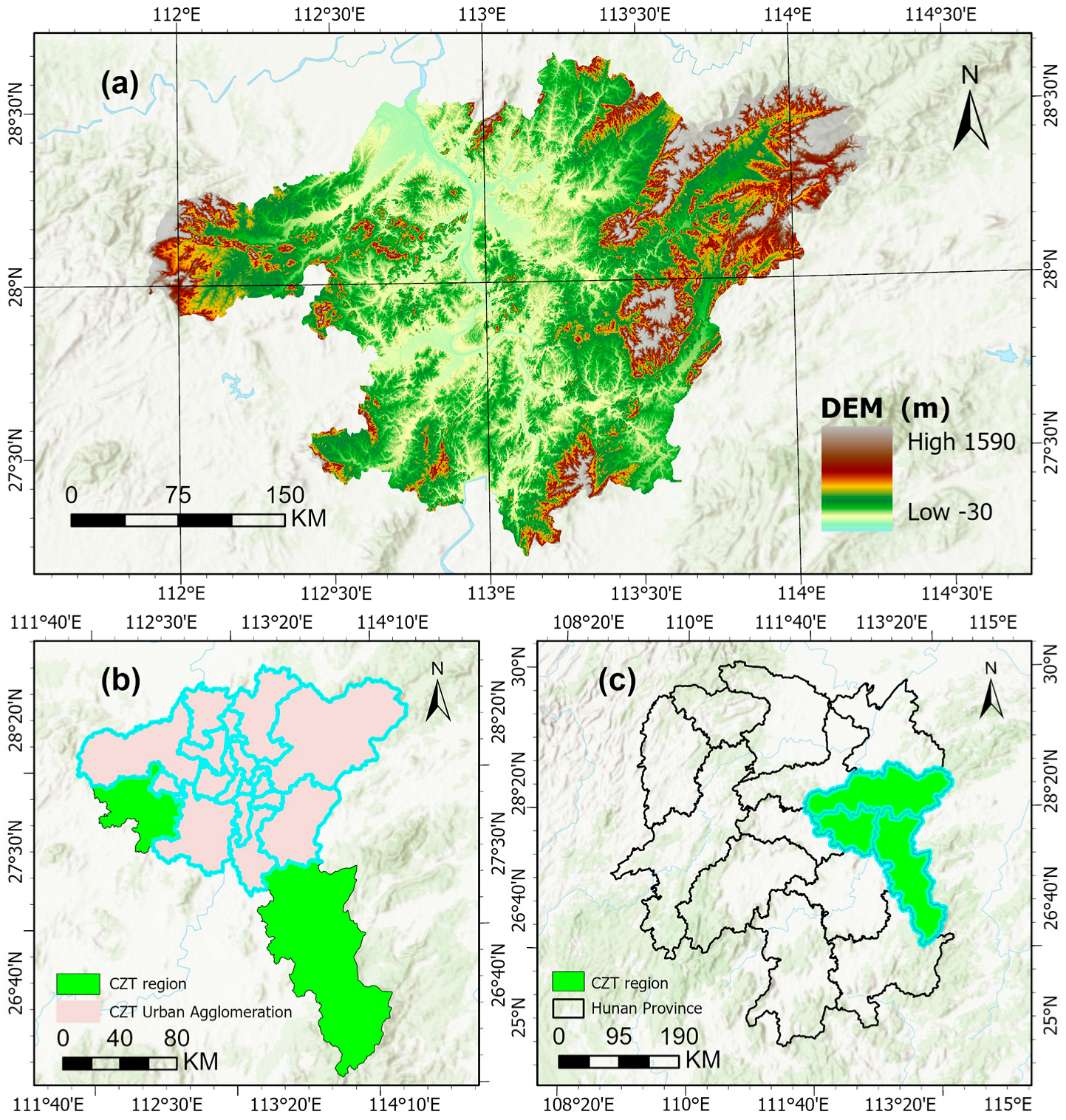
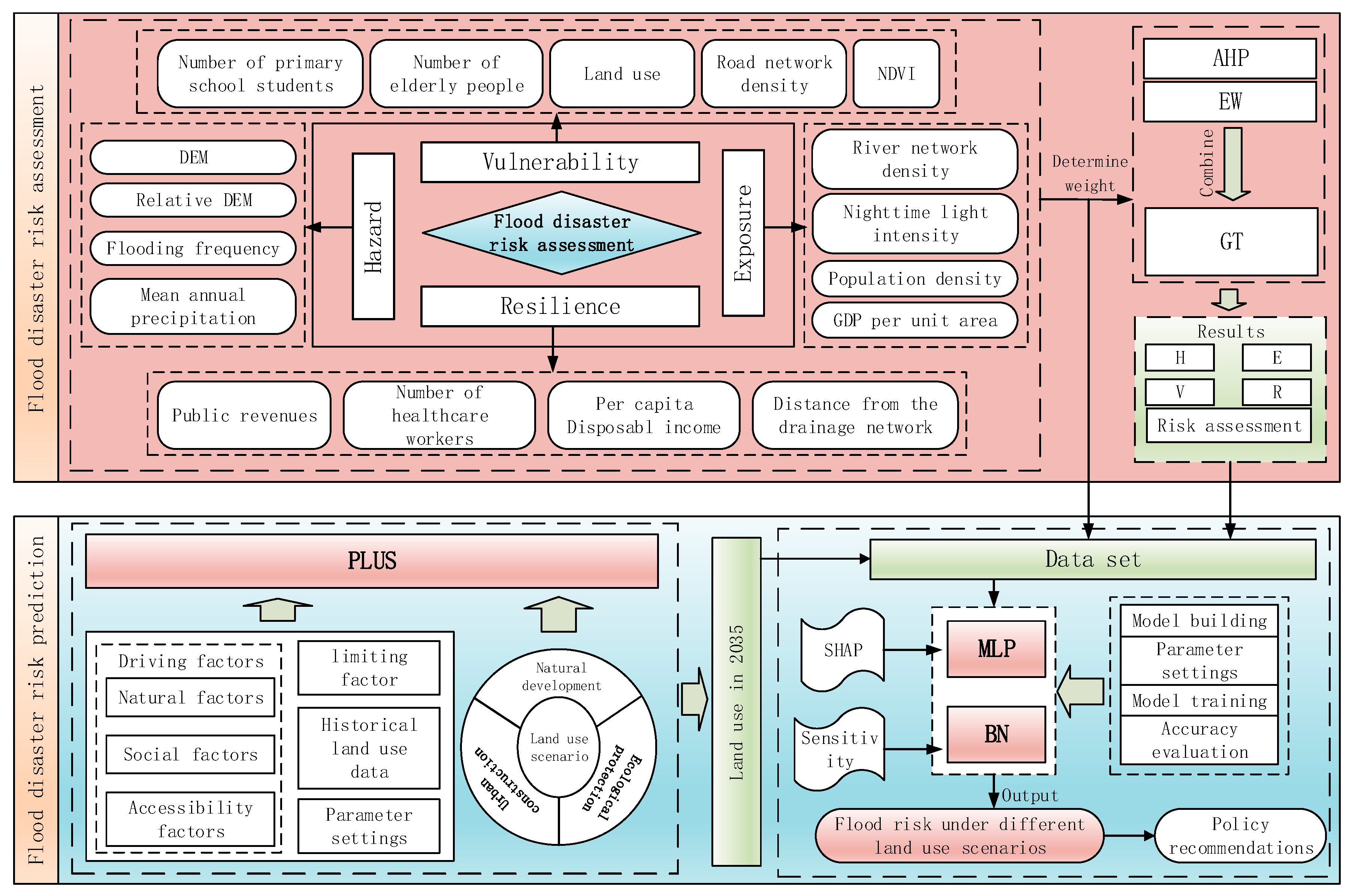


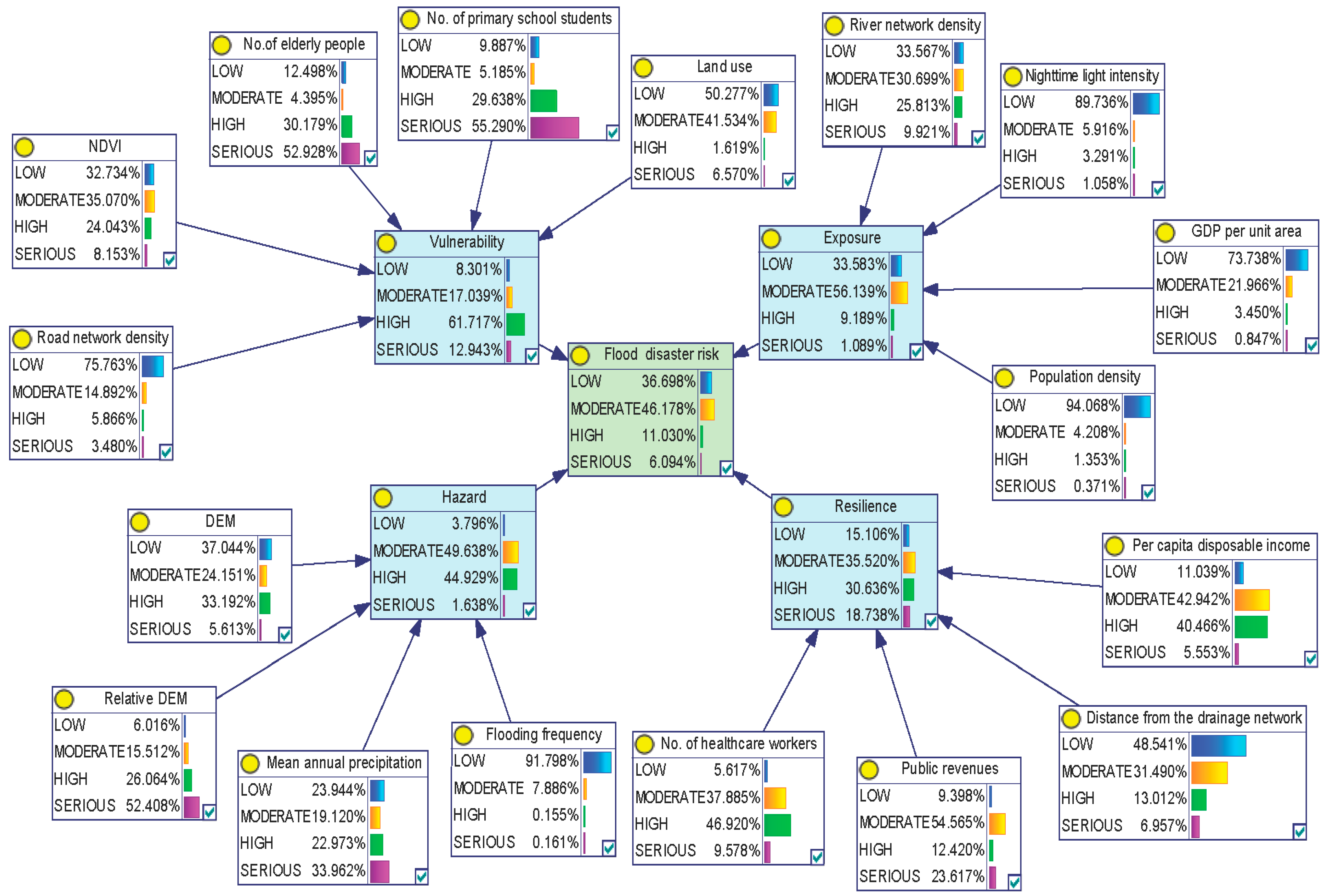

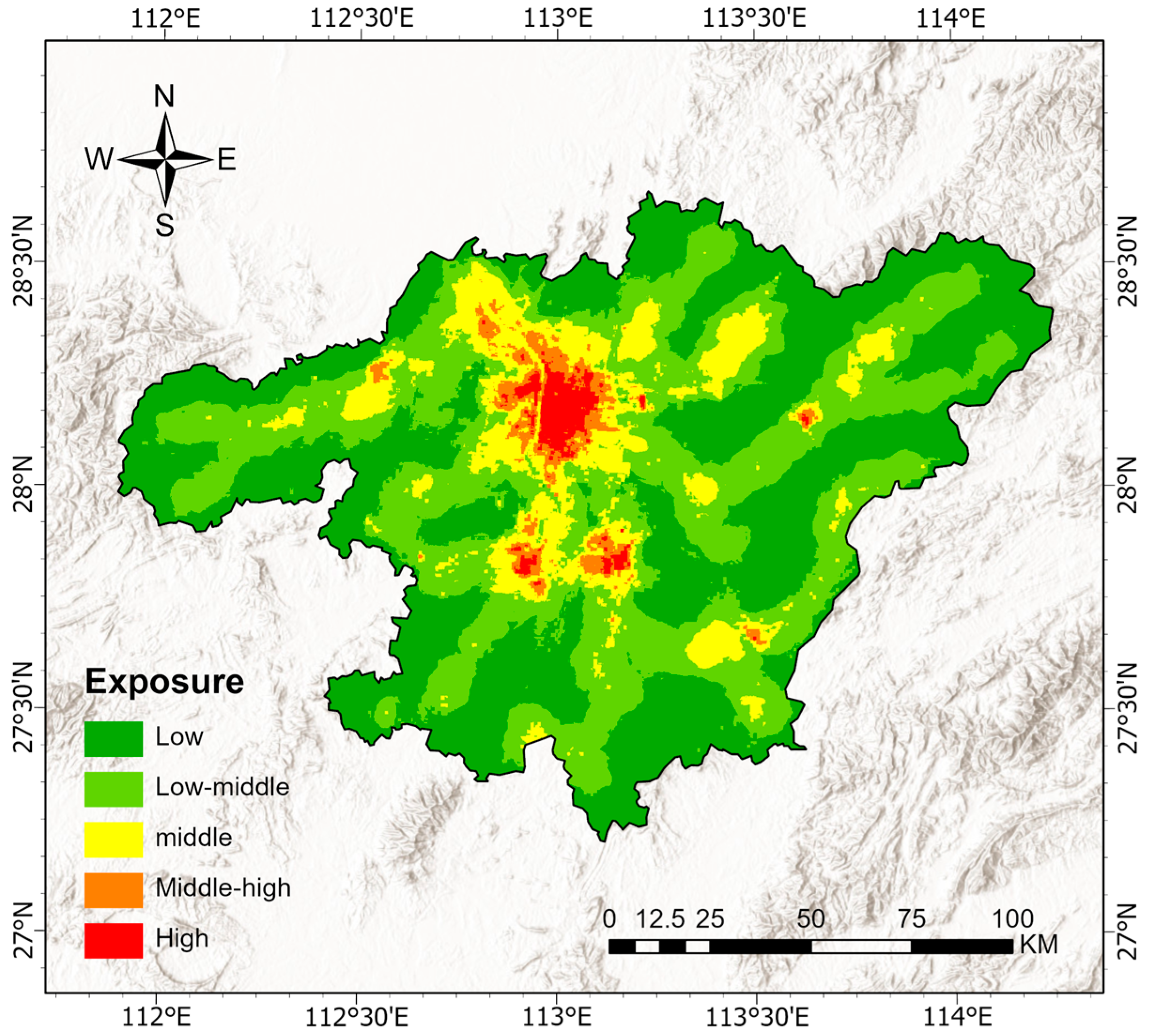

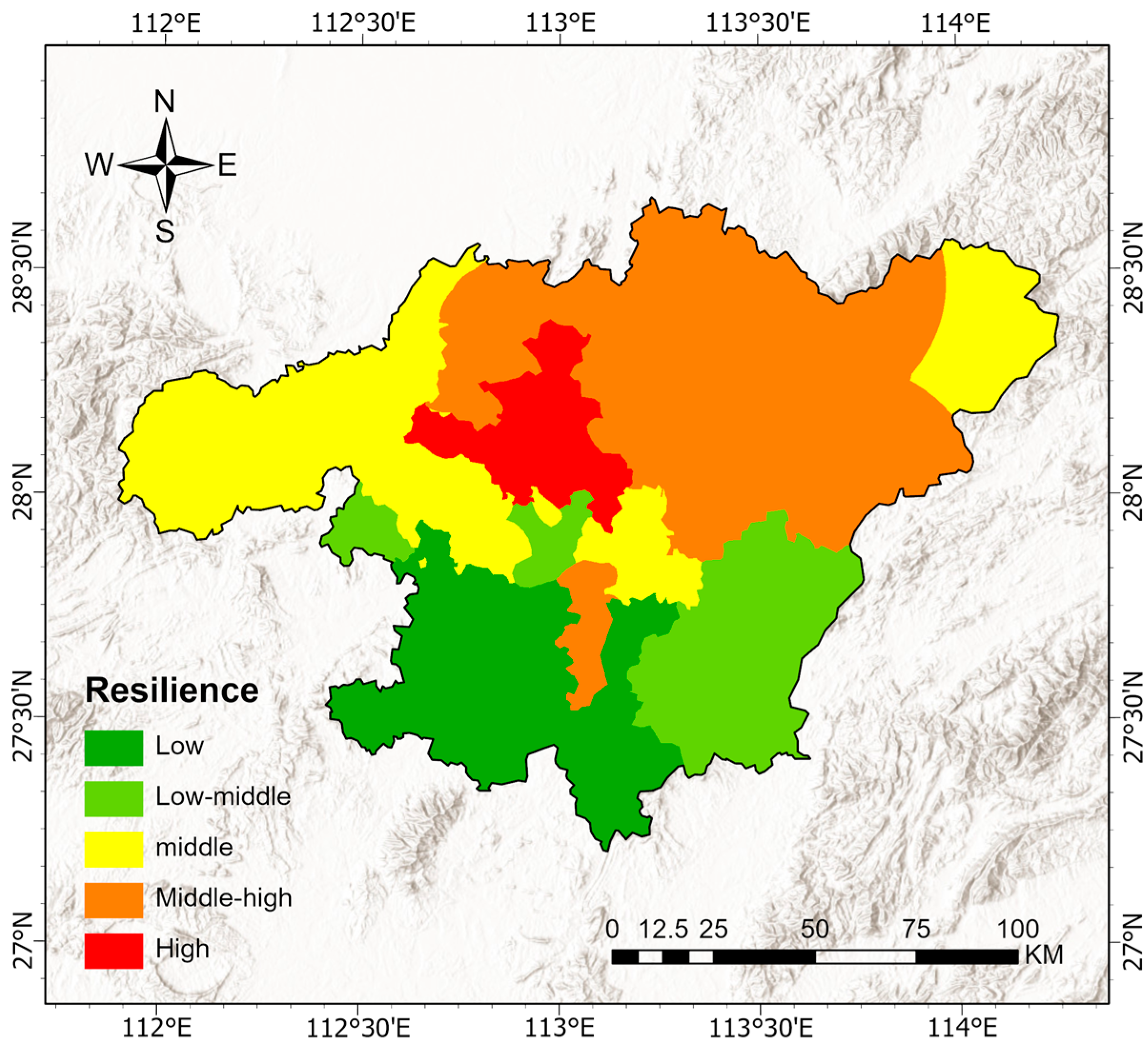
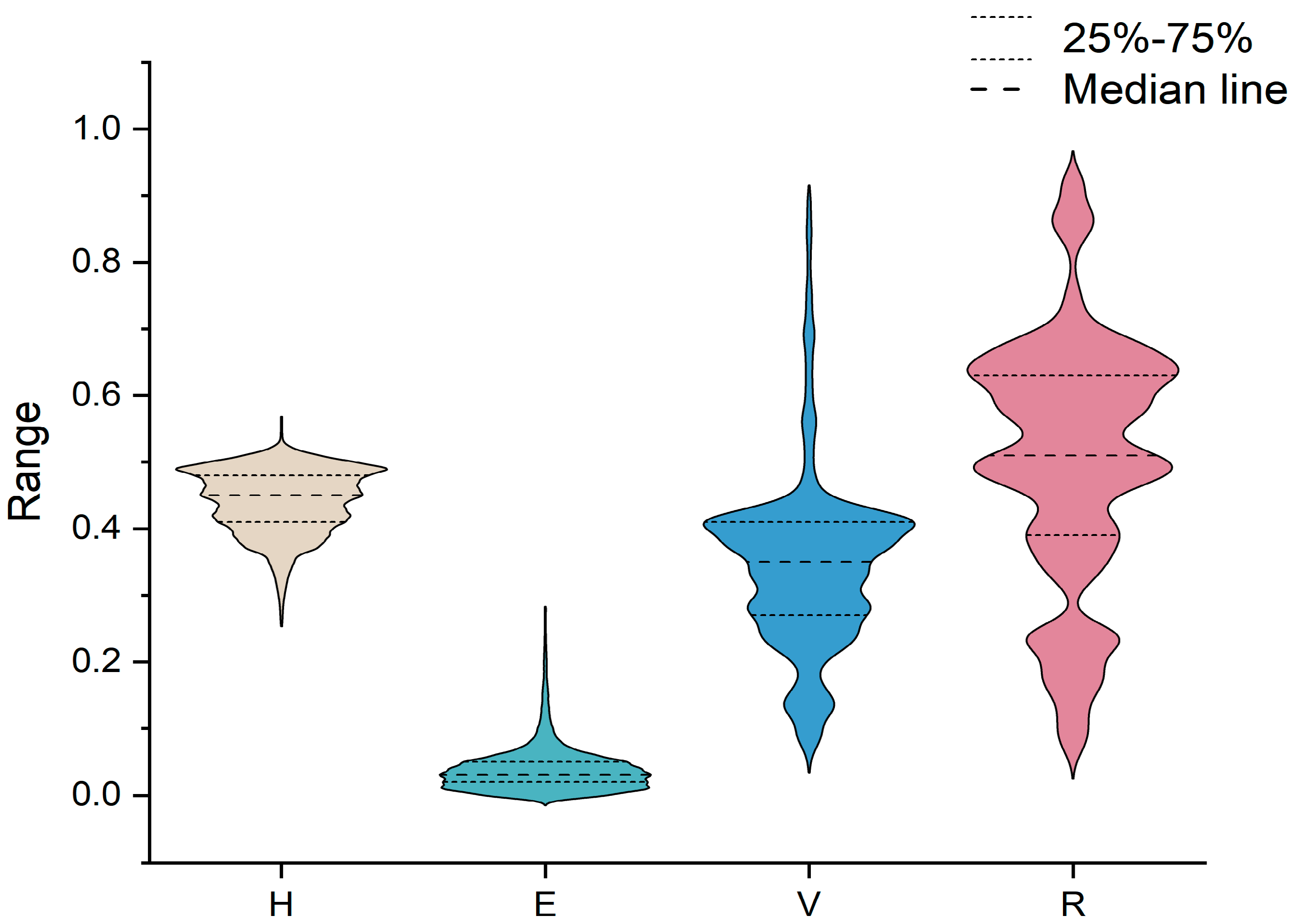
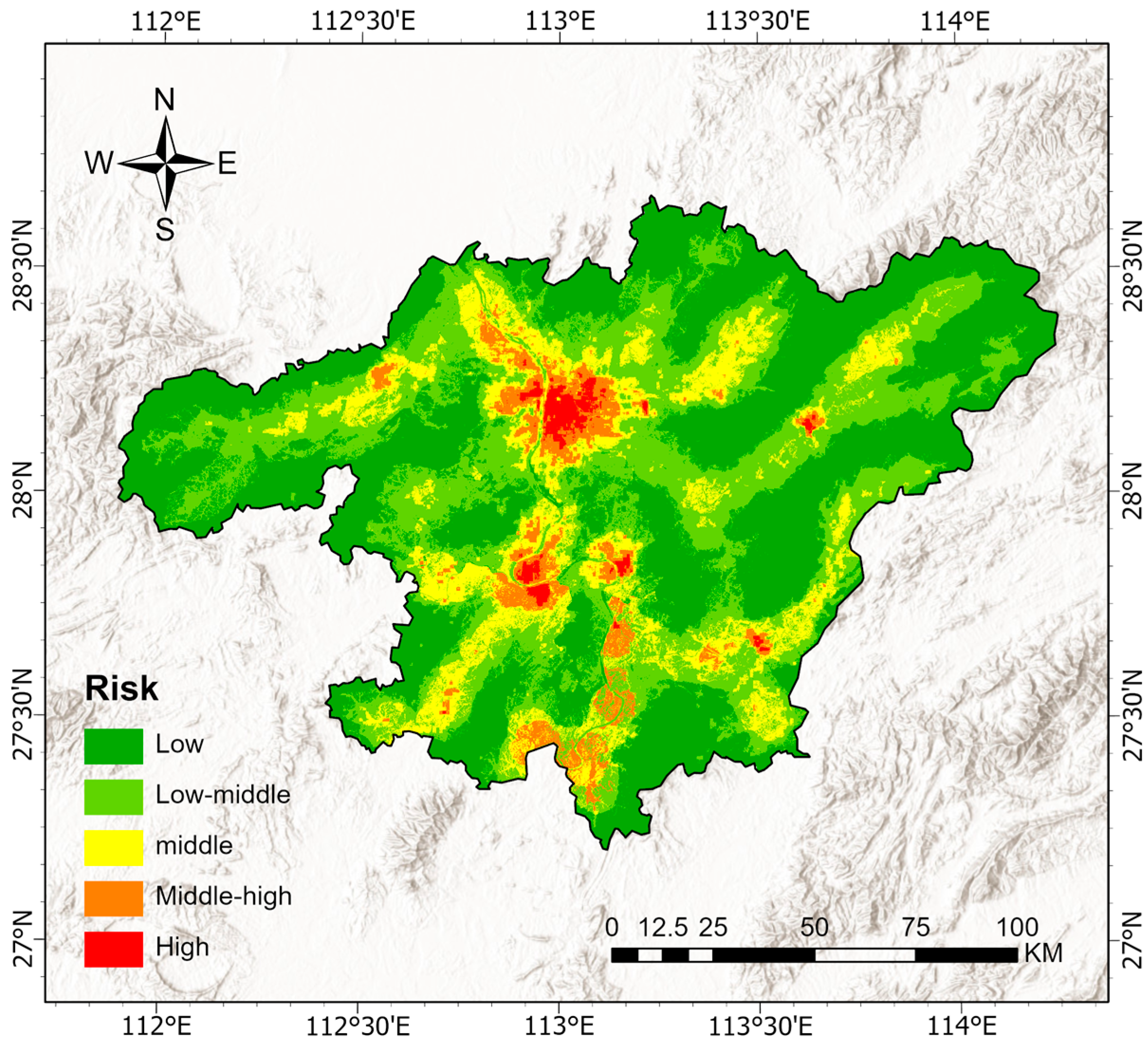
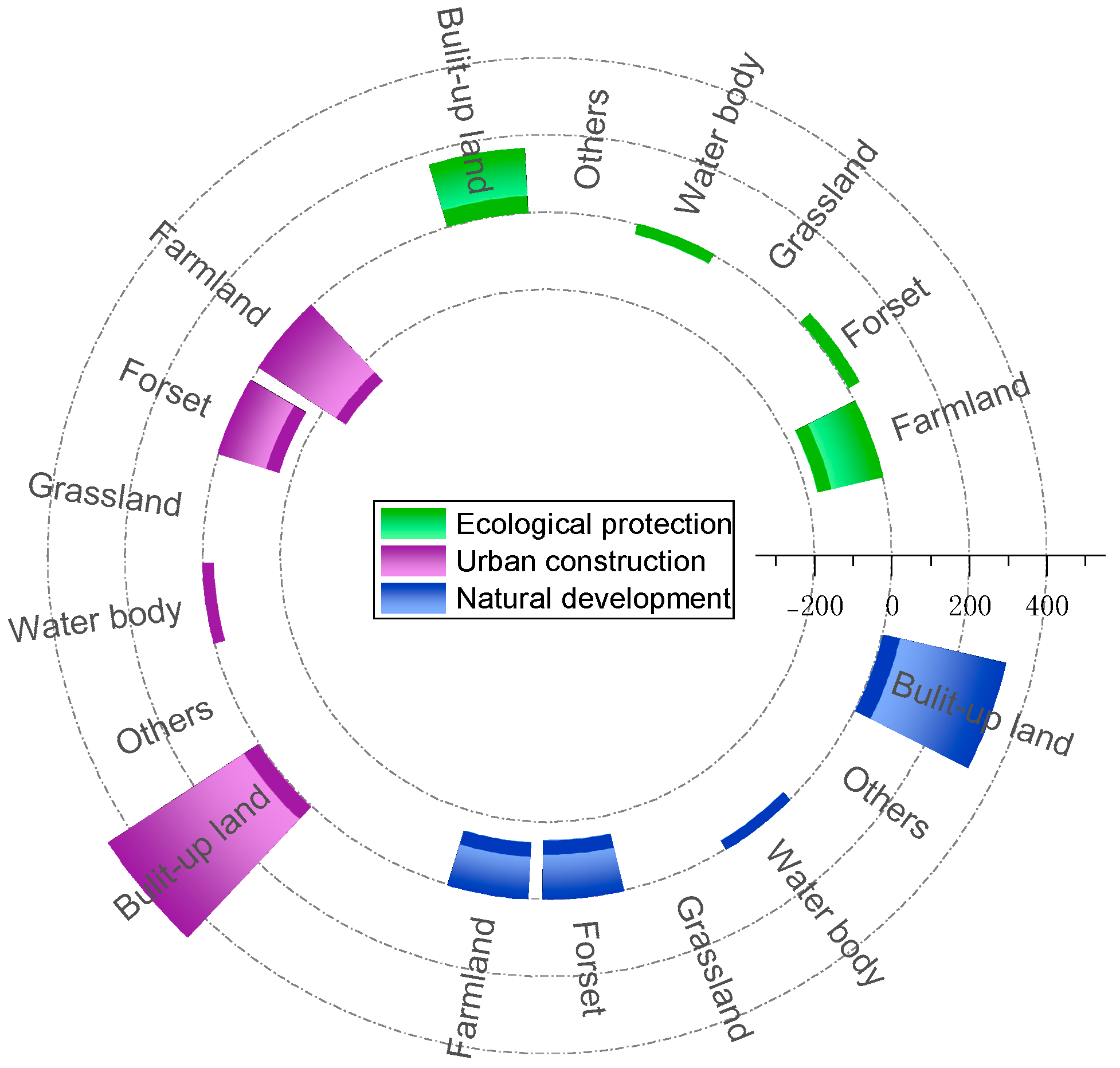
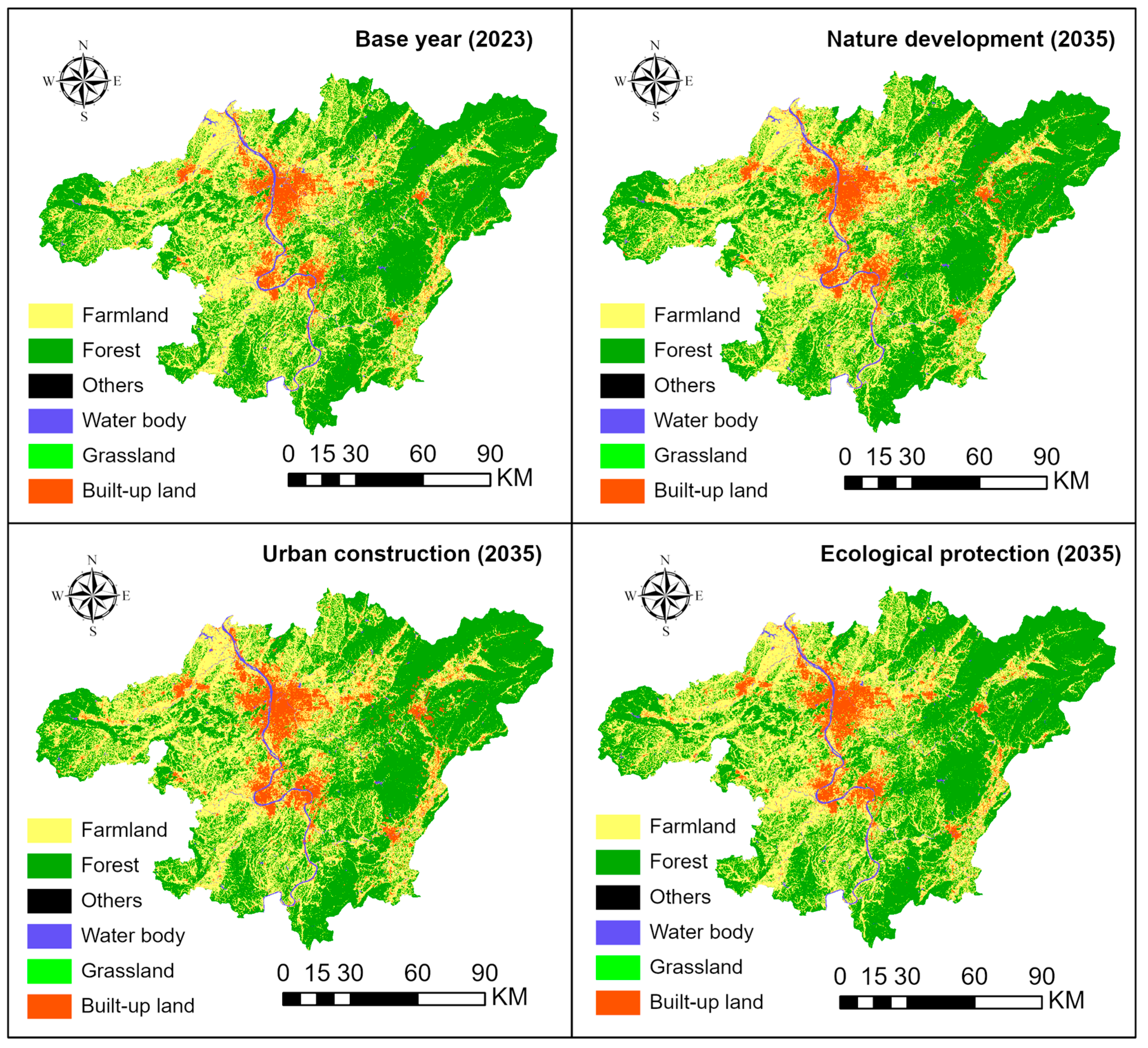

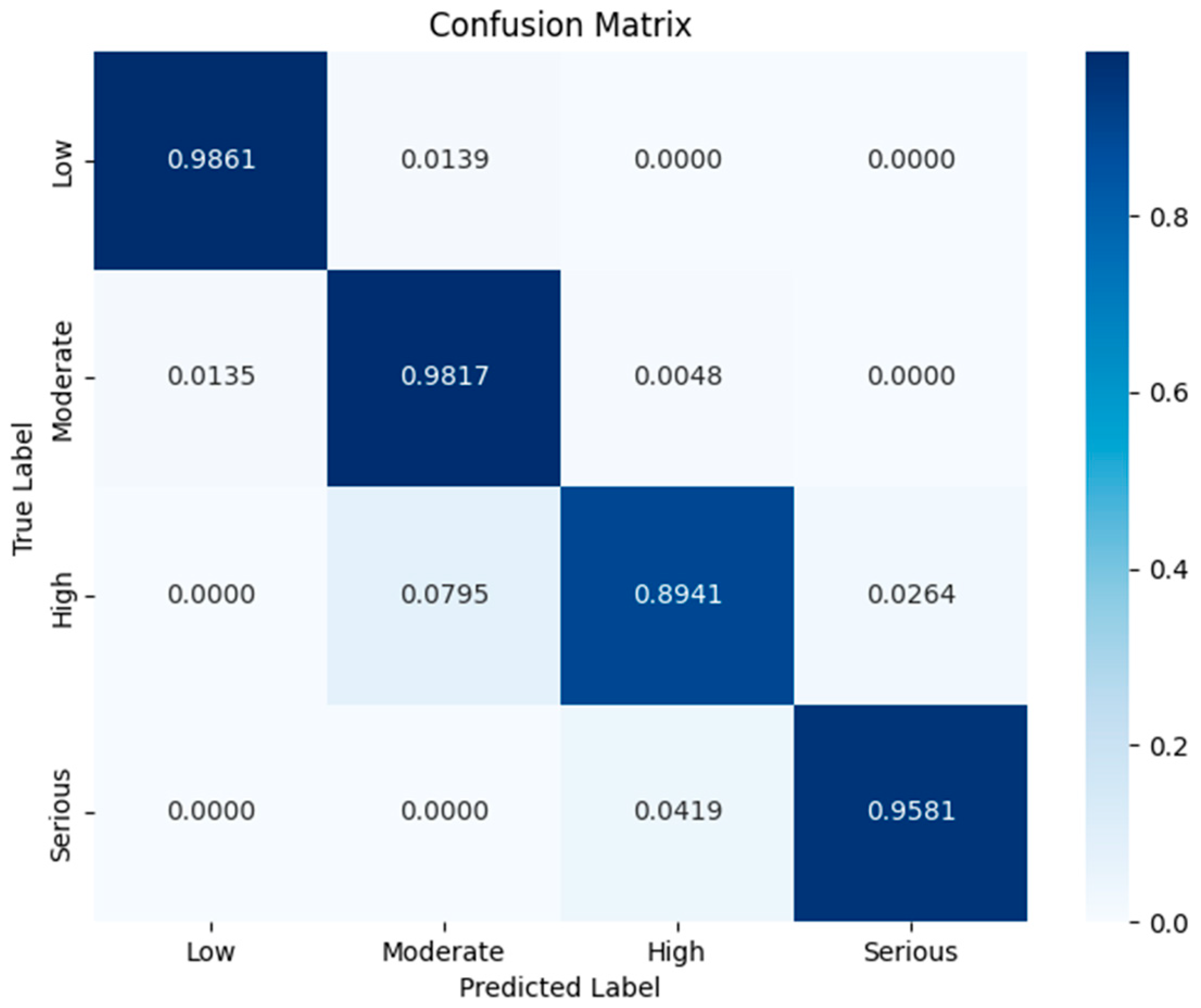
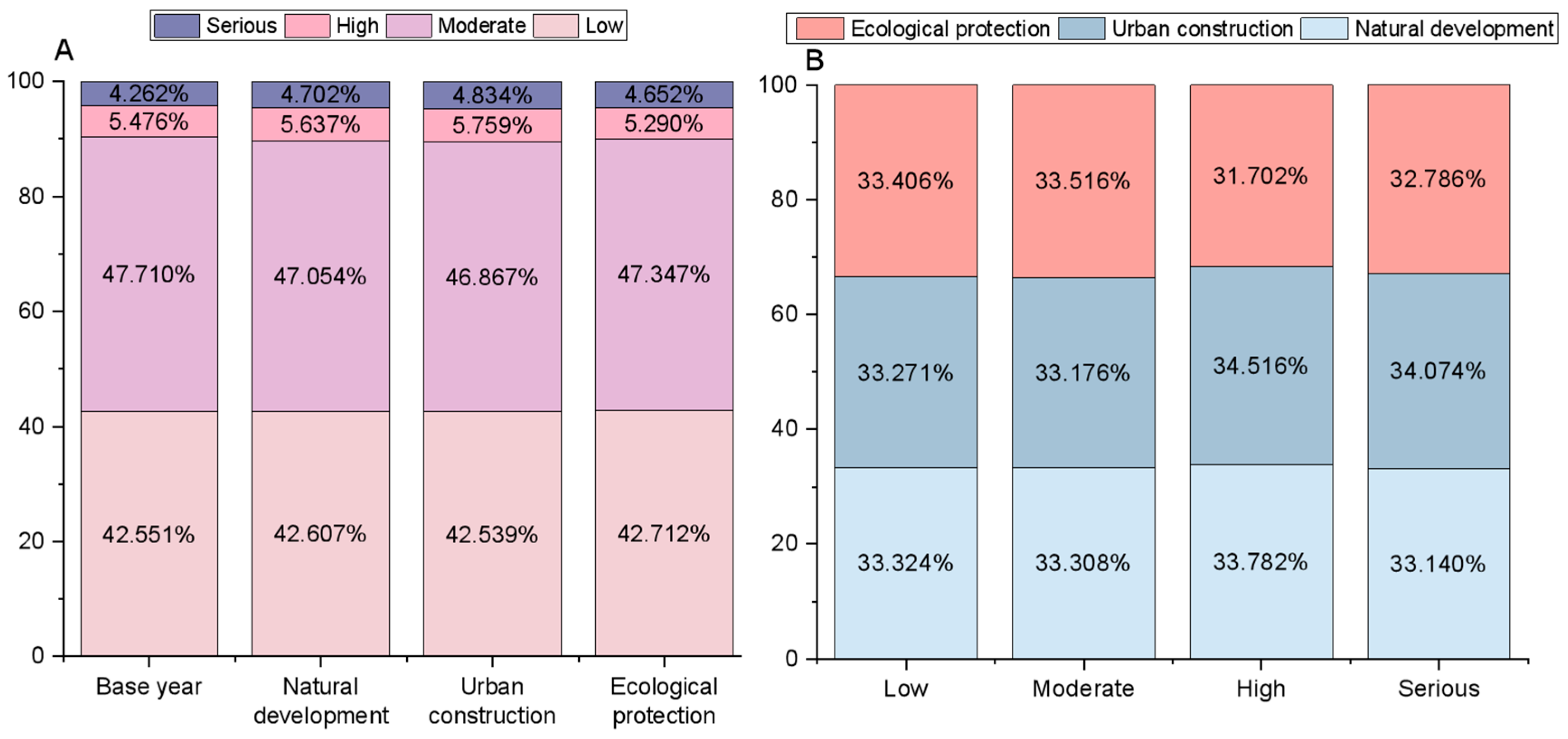

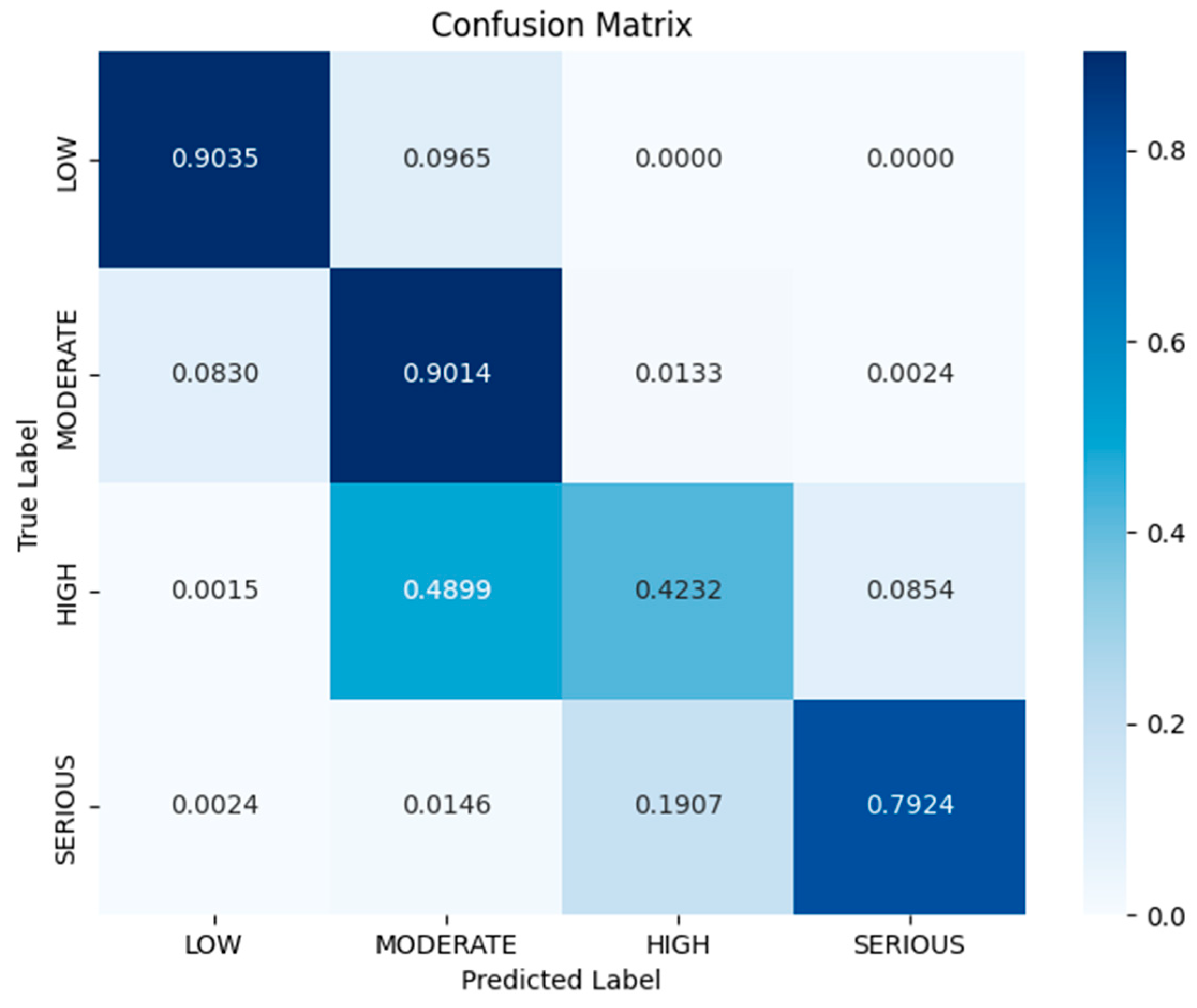

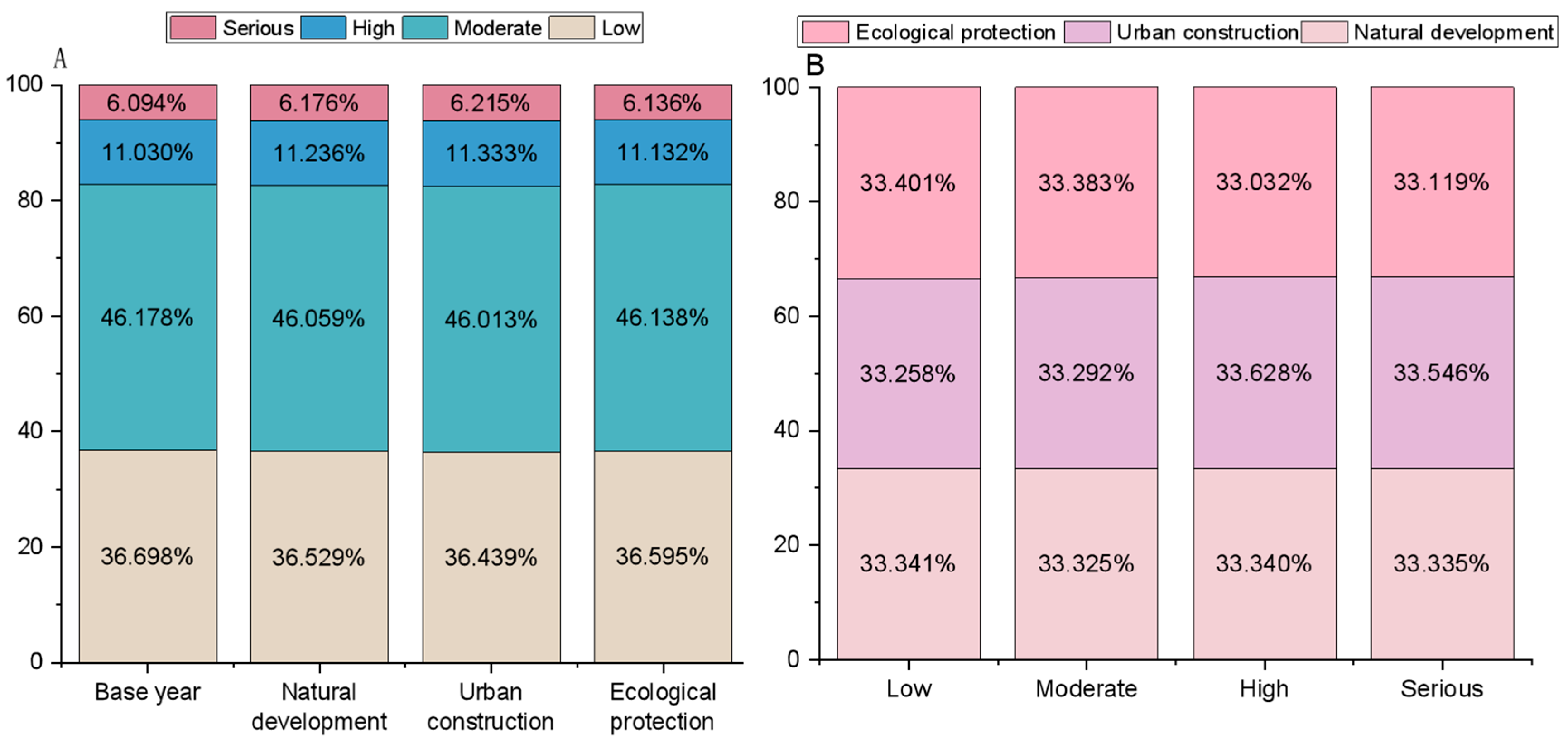
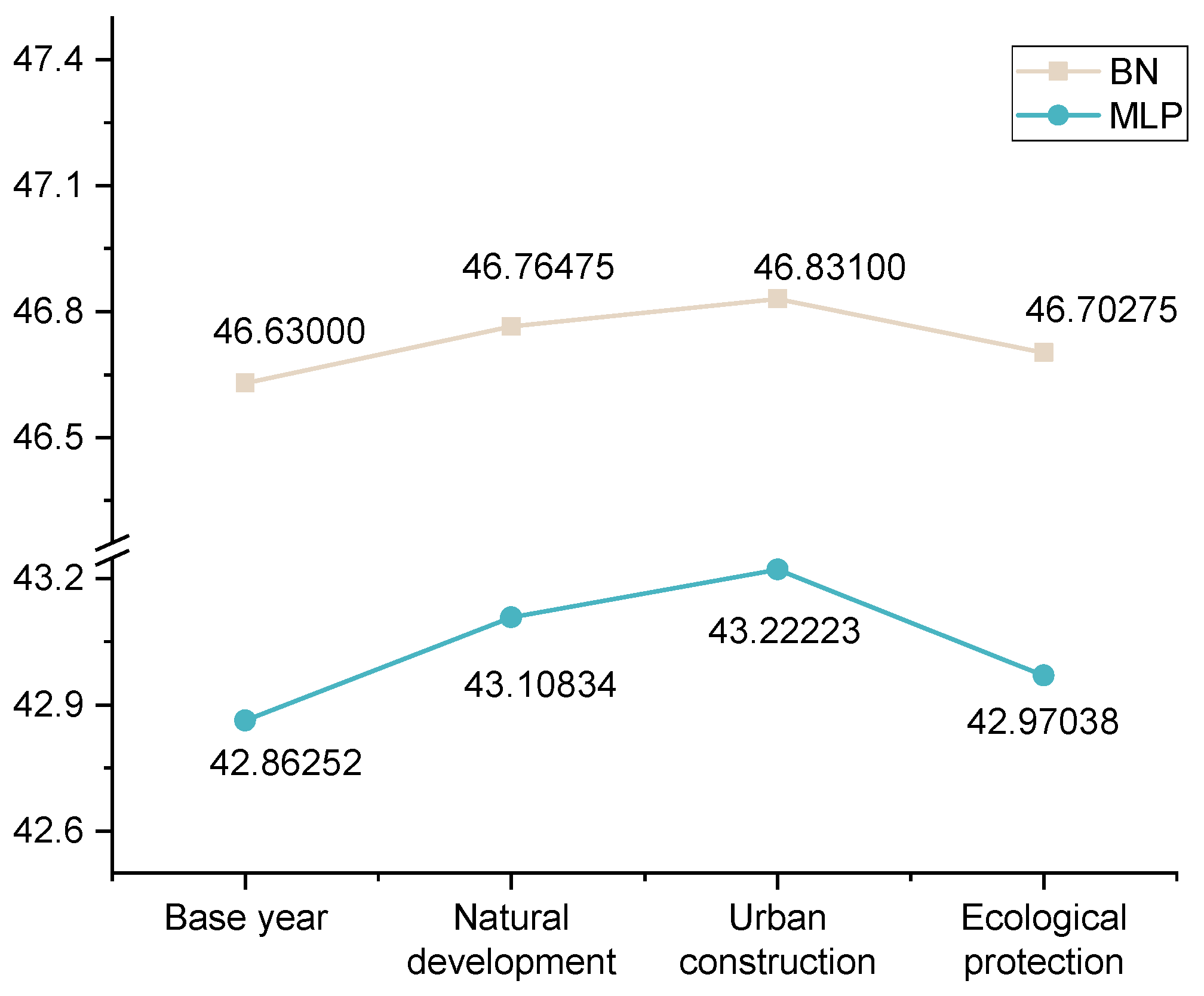
| Data and Indicator | Resolution | Data Source |
|---|---|---|
| Mean annual precipitation and temperature station data | / | National Oceanic and Atmospheric Administration: https://www.ncei.noaa.gov/data/global-summary-of-the-day/archive/ accessed on 13 August 2025 |
| Nighttime light intensity | 250 m × 250 m | |
| DEM | 12.5 m × 12.5 m | NASA: https://www.nasa.gov/ accessed on 13 August 2025 |
| Slope | 30 m × 30 m | Extracted DEM |
| River network density | ||
| NDVI | 250 m × 250 m | MODIS Imagery (2014–2023 MOD09Q1 Products) Extraction: https://ladsweb.modaps.eosdis.nasa.gov/search/ accessed on 13 August 2025 |
| Flooding frequency | ||
| Population density | 1 km × 1 km | LandScan data from the U.S. Department of Energy’s Oak Ridge National Laboratory: https://landscan.ornl.gov accessed on 13 August 2025 |
| GDP per unit area | 1 km × 1 km | Resource and Environmental Science and Data Center, Chinese Academy of Sciences: https://www.resdc.cn/ accessed on 13 August 2025 |
| Distance from the drainage network | 30 m × 30 m | Open Street Map: https://www.openstreetmap.org/ accessed on 13 August 2025 |
| Road network density | ||
| Land use | The Wuhan University CLCD dataset: https://doi.org/10.5281/zenodo.4417809 accessed on 13 August 2025 | |
| Per capita disposable income | / | Statistical Yearbook of Hunan Province and Chang-Zhu-Tan Three Cities |
| Number of healthcare workers | ||
| Public revenues | ||
| Number of primary school students | ||
| Number of elderly people | ||
| Distance from first-class, second-class, and third-class roads, distance from the district/county center, distance from highway, distance from the railway | 30 m × 30 m | Euclidean Distance Analysis by Open Street Map Data |
| Administrative districts | / | National Platform for Common GeoSpatial Information Services: https://cloudcenter.tianditu.gov.cn/administrativeDivision accessed on 13 August 2025 |
| Indicator | VIF | Indicator | VIF |
|---|---|---|---|
| Mean annual precipitation (X1) | 1.69 | Number of elderly people (X10) | 4.03 |
| DEM (X2) | 2.61 | Road network density (X11) | 3.62 |
| Relative DEM (X3) | 2.54 | NDVI (X12) | 2.75 |
| Flooding frequency (X4) | 1.04 | Land use (X13) | 2.34 |
| Population density (X5) | 2.08 | Per capita disposable income (X14) | 4.37 |
| River network density (X6) | 1.34 | Number of healthcare workers (X15) | 8.93 |
| GDP per unit area (X7) | 2.39 | Public revenues (X16) | 7.43 |
| Nighttime light intensity (X8) | 4.02 | Distance from the drainage network (X17) | 1.45 |
| Number of primary school students (X9) | 4.33 |
| Criterion Layer | Indicator Layer | AHP | EW | GT | Impact on Criterion Layer |
|---|---|---|---|---|---|
| H | Mean annual precipitation | 0.1017 | 0.0034 | 0.0448 | + |
| DEM | 0.0709 | 0.0671 | 0.0687 | − | |
| Relative DEM | 0.062 | 0.0263 | 0.0413 | − | |
| Flooding frequency | 0.0744 | 0.1686 | 0.1289 | + | |
| E | Population density | 0.0416 | 0.1331 | 0.0946 | + |
| River network density | 0.0490 | 0.0089 | 0.0258 | + | |
| GDP per unit area | 0.0290 | 0.0967 | 0.0682 | + | |
| Nighttime light intensity | 0.0188 | 0.1241 | 0.0797 | + | |
| V | Number of primary school students | 0.0610 | 0.0544 | 0.0572 | + |
| Number of elderly people | 0.0225 | 0.0483 | 0.0375 | + | |
| Road network density | 0.0444 | 0.0761 | 0.0628 | + | |
| NDVI | 0.0441 | 0.0203 | 0.0303 | / | |
| Land use | 0.0482 | 0.0712 | 0.0614 | / | |
| R | Per capita disposable income | 0.1657 | 0.0339 | 0.0894 | + |
| Number of healthcare workers | 0.0695 | 0.0227 | 0.0424 | + | |
| Public revenues | 0.0424 | 0.0257 | 0.0327 | + | |
| Distance from the drainage network | 0.0548 | 0.0192 | 0.0342 | − |
| Data | Grade | |||
|---|---|---|---|---|
| Low | Moderate | High | Serious | |
| Mean annual precipitation | <1826.5 | 1826.5–1919.6 | 1919.6–2000.1 | >2000.1 |
| DEM | >120 | 80–120 | 40–80 | <40 |
| Relative DEM | >18.1 | 10.5–18.1 | 4.8–10.5 | <4.5 |
| Flooding frequency | <1 | 1–3 | 3–5 | >5 |
| Population density | <1323 | 1323–4542 | 4542–11,438 | >11,438 |
| River network density | <0.053 | 0.053–0.125 | 0.125–0.199 | >0.199 |
| GDP per unit area | <8207 | 8207–33,053 | 33,053–105,221 | >105,221 |
| Nighttime light intensity | <5.97 | 5.97–19.52 | 19.52–38.14 | >38.14 |
| Number of primary school students | <30,667 | 30,667–48,175 | 48,175–82,506 | 82,506 |
| Number of elderly people | <61,657 | 61,657–95,682 | 95,682–150,218 | >95,682 |
| Road network density | <0.46 | 0.46–1.26 | 1.26–2.55 | >2.55 |
| NDVI | >0.63 | 0.49–0.63 | 0.33–0.49 | <0.33 |
| Land use | Forest, others | Farmland, grassland | Water body | Built-up land |
| Per capita disposable income | >54,866 | 47,763–54,866 | 32,626–47,763 | <32,626 |
| Number of healthcare workers | >10,110 | 6848–10,110 | 2909–6848 | <2909 |
| Public revenues | >1,011,440 | 393,730–1,011,440 | 161,072–393,730 | <393,730 |
| Distance from the drainage network | <9652.99 | 9652.99–21,038.57 | 21,038.57–35,889.33 | >35,889.33 |
| Hazard | <0.35 | 0.35–0.46 | 0.46–0.55 | >0.55 |
| Exposure | <0.03 | 0.03–0.08 | 0.08–0.15 | >0.15 |
| Vulnerability | <0.11 | 0.11–0.25 | 0.25–0.50 | >0.50 |
| Resilience | >0.74 | 0.53–0.74 | 0.32–0.53 | <0.32 |
| Flood risk | <0.08 | 0.08–0.26 | 0.26–0.50 | >0.50 |
| Fold n | 1 | 2 | 3 | 4 | 5 | 6 | 7 | 8 | 9 | 10 | Average |
|---|---|---|---|---|---|---|---|---|---|---|---|
| Error rate (%) | 2.13 | 2.11 | 2.15 | 2.07 | 2.25 | 2.05 | 2.19 | 2.31 | 1.87 | 2.63 | 2.17 |
| Fold n | 1 | 2 | 3 | 4 | 5 | 6 | 7 | 8 | 9 | 10 | Average |
|---|---|---|---|---|---|---|---|---|---|---|---|
| Error rate (%) | 12.56 | 12.46 | 11.94 | 12.74 | 12.2 | 13.53 | 13.85 | 14.03 | 12.28 | 12.98 | 12.86 |
Disclaimer/Publisher’s Note: The statements, opinions and data contained in all publications are solely those of the individual author(s) and contributor(s) and not of MDPI and/or the editor(s). MDPI and/or the editor(s) disclaim responsibility for any injury to people or property resulting from any ideas, methods, instructions or products referred to in the content. |
© 2025 by the authors. Licensee MDPI, Basel, Switzerland. This article is an open access article distributed under the terms and conditions of the Creative Commons Attribution (CC BY) license (https://creativecommons.org/licenses/by/4.0/).
Share and Cite
Zhang, T.; Wu, K.; Wang, X.; Li, X.; Li, L.; Chen, L. Impact of Land Use Patterns on Flood Risk in the Chang-Zhu-Tan Urban Agglomeration, China. Remote Sens. 2025, 17, 2889. https://doi.org/10.3390/rs17162889
Zhang T, Wu K, Wang X, Li X, Li L, Chen L. Impact of Land Use Patterns on Flood Risk in the Chang-Zhu-Tan Urban Agglomeration, China. Remote Sensing. 2025; 17(16):2889. https://doi.org/10.3390/rs17162889
Chicago/Turabian StyleZhang, Ting, Kai Wu, Xiulian Wang, Xinai Li, Long Li, and Longqian Chen. 2025. "Impact of Land Use Patterns on Flood Risk in the Chang-Zhu-Tan Urban Agglomeration, China" Remote Sensing 17, no. 16: 2889. https://doi.org/10.3390/rs17162889
APA StyleZhang, T., Wu, K., Wang, X., Li, X., Li, L., & Chen, L. (2025). Impact of Land Use Patterns on Flood Risk in the Chang-Zhu-Tan Urban Agglomeration, China. Remote Sensing, 17(16), 2889. https://doi.org/10.3390/rs17162889







